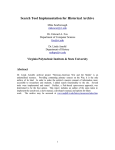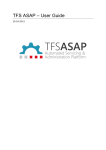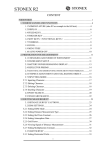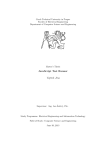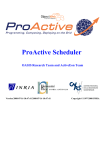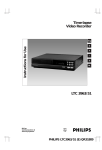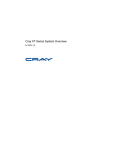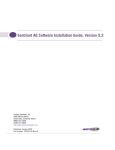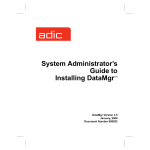Download Cray Inc. Welder s-2340-21 User's Manual
Transcript
CrayDoc™ Installation and Administration Guide S–2340–21 © 2001–2003 Cray Inc. All Rights Reserved. This manual or parts thereof may not be reproduced in any form unless permitted by contract or by written permission of Cray Inc. U.S. GOVERNMENT RESTRICTED RIGHTS NOTICE The Computer Software is delivered as "Commercial Computer Software" as defined in DFARS 48 CFR 252.227-7014. All Computer Software and Computer Software Documentation acquired by or for the U.S. Government is provided with Restricted Rights. Use, duplication or disclosure by the U.S. Government is subject to the restrictions described in FAR 48 CFR 52.227-14 or DFARS 48 CFR 252.227-7014, as applicable. Technical Data acquired by or for the U.S. Government, if any, is provided with Limited Rights. Use, duplication or disclosure by the U.S. Government is subject to the restrictions described in FAR 48 CFR 52.227-14 or DFARS 48 CFR 252.227-7013, as applicable. Autotasking, CF77, Cray, Cray Ada, Cray Channels, Cray Chips, CraySoft, Cray Y-MP, Cray-1, CRInform, CRI/TurboKiva, HSX, LibSci, MPP Apprentice, SSD, SuperCluster, UNICOS, UNICOS/mk, and X-MP EA are federally registered trademarks and Because no workstation is an island, CCI, CCMT, CF90, CFT, CFT2, CFT77, ConCurrent Maintenance Tools, COS, Cray Animation Theater, Cray APP, Cray C90, Cray C90D, Cray CF90, Cray C++ Compiling System, CrayDoc, Cray EL, Cray Fortran Compiler, Cray J90, Cray J90se, Cray J916, Cray J932, CrayLink, Cray MTA, Cray MTA-2, Cray MTX, Cray NQS, Cray/REELlibrarian, Cray S-MP, Cray SSD-T90, Cray SV1, Cray SV1ex, Cray SV2, Cray SX-5, Cray SX-6, Cray T90, Cray T94, Cray T916, Cray T932, Cray T3D, Cray T3D MC, Cray T3D MCA, Cray T3D SC, Cray T3E, CrayTutor, Cray X1, Cray X-MP, Cray XMS, Cray-2, CSIM, CVT, Delivering the power . . ., DGauss, Docview, EMDS, GigaRing, HEXAR, IOS, ND Series Network Disk Array, Network Queuing Environment, Network Queuing Tools, OLNET, RQS, SEGLDR, SMARTE, SUPERLINK, System Maintenance and Remote Testing Environment, Trusted UNICOS, UNICOS MAX, and UNICOS/mp are trademarks of Cray Inc. IRIX is a trademark of Silicon Graphics, Inc. Linux is a trademark of Linus Torvalds. Netscape and the Netscape N and Ship’s Wheel logos are registered trademarks of Netscape Communications Corporation in the U.S. and other countries. PostScript is a trademark of Adobe Systems, Inc. Red Hat is a trademark of Red Hat, Inc. Solaris is a trademark of Sun Microsystems, Inc. UNIX, the “X device,” X Window System, and X/Open are trademarks of The Open Group in the United States and other countries. All other trademarks are the property of their respective owners. New Features CrayDoc™ Installation and Administration Guide This book documents the following new features of CrayDoc 2.0 release: • Complete rewrite of the Perl scripts, with attention to security issues • Administration now from the cdadmin command line tool • Highlighting of search results • Man pages now available in HTML format • Glossary of software terms available online • Advanced search options This book also includes revised information in Section 6.6. S–2340–21 Record of Revision Version Description 1.0 December 2001 Original Printing. 2.0 December 2002 Updated to reflect new features in CrayDoc 2.0 release. 2.1 February 2003 Updated to include changes in Section 6.6, Upgrading from version 1.0. S–2340–21 i Contents Page Preface v Ordering Documentation Conventions . . Reader Comments . . . . . . . . . . . . . . . . . . . . . . v . . . . . . . . . . . . . . . . . . . . . . . . vi . . . . . . . . . . . . . . . . . . . . . . . . vii Introduction [1] Compatibility 1 . . . . . . . . . . . . . . . . . . . . . . . . . 1 Software Requirements . . . . . . . . . . . . . . . . . . . . . . . 2 Apache . . . . . . . . . . . . . . . . . . . . . . . . . . . 2 Perl . . . . . . . . . . . . . . . . . . . . . . . . . . . 2 . . . . . . . . . . . . . . . . 3 . Berkeley Database and DB_File Module The CGI Perl Module . . The Dumper.pm Perl Module . . . . . . . . . . . . . . . . . . . . 3 . . . . . . . . . . . . . . . . . . . . 3 . . . . . . . . . . . . . . . . 4 Sendmail.pm and Order Form Function Hardware Requirements RAM . . . . Hard Drive Space . . . . . . . . . . . . . . . . . . . . . . 4 . . . . . . . . . . . . . . . . . . . . . . . 4 . . . . . . . . . . . . . . . . . . . . . . . 5 Preparing for Installation [2] Stand-alone Mode Shared Mode . Security Issues suEXEC . 7 . . . . . . . . . . . . . . . . . . . . . . . . 7 . . . . . . . . . . . . . . . . . . . . . . . . . 8 . . . . . . . . . . . . . . . . . . . . . . . . . 8 . . . . . . . . . . . . . . . . . . . . . . . . . 9 . . . . . . . . . . . . . . . . . . . . 9 Understanding permissions Configuring Apache [3] Apache in Stand-alone Mode S–2340–21 11 . . . . . . . . . . . . . . . . . . . . . 12 iii CrayDoc™ Installation and Administration Guide Page Apache in Shared Mode . . . Apache Tips and Troubleshooting . . . . . . . . . . . . . . . . . . . 12 . . . . . . . . . . . . . . . . . . . 13 Installing CrayDoc [4] 15 Automated Installation . . . . . . . . . . . . . . . . . . . . . . . 15 Manual Installation . . . . . . . . . . . . . . . . . . . . . . . . 16 . . . . . . . . . . . . . . . . . . . . . . . . 16 . . . . . . . . . . . . . . . . . . . . 18 . . . . . . . . . . . . . . . . . . . . . 21 . . . . . . . . . . . . . . . . . . . . . 22 CD Contents . The craydoc-config File Copying and Unpacking The HTML Interface . . Cray Documentation [5] Man Pages Books . . 23 . . . . . . . . . . . . . . . . . . . . . . . . . . 23 . . . . . . . . . . . . . . . . . . . . . . . . . . 24 Administration [6] Tools . . . . 25 . . . . . . . . . . . . . . . . . . . . . . . . 25 The cdadmin tool . . . . . . . . . . . . . . . . . . . . . . . . 26 The Search Engine . . . . . . . . . . . . . . . . . . . . . . . . 27 . . . . . . . . . . . . . . . . . . . . . . 28 . . . . . . . . . . . . . . . . . . . . . . 29 . . . . . . . . . . . . . . . . . . . . . 30 . . . . . . . . . . . . . . . . 30 Contents of $ScriptAlias Moving CrayDoc . . Upgrading from version 1.0 Procedure 1: Example 1: . . . . . . . . . . . . . . . . . . . . . . . . . 30 Example 2: . . . . . . . . . . . . . . . . . . . . . . . . . 30 Example 3: . . . . . . . . . . . . . . . . . . . . . . . . . 31 . . . . . . . . . . . . . . . 31 Example 4: Index iv Upgrading to CrayDoc 2.0 Moving the manuals/ directory 33 S–2340–21 Preface This publication describes CrayDoc 2.0 release and installing and administering CrayDoc and Cray documentation. Ordering Documentation To order software documentation, contact the Cray Software Distribution Center in any of the following ways: E-mail: [email protected] Web: http://www.cray.com/craydoc/ Click on the Cray Publications Order Form link. Telephone (inside U.S., Canada): 1–800–284–2729 (BUG CRAY), then 605–9100 Telephone (outside U.S., Canada): Contact your Cray representative, or call +1–651–605–9100 Fax: +1–651–605–9001 Mail: Software Distribution Center Cray Inc. 1340 Mendota Heights Road Mendota Heights, MN 55120–1128 USA S–2340–21 v CrayDoc™ Installation and Administration Guide Conventions The following conventions are used throughout this document: vi Convention Meaning command This fixed-space font denotes literal items, such as file names, pathnames, man page names, command names, and programming language elements. variable Italic typeface indicates an element that you will replace with a specific value. For instance, you may replace filename with the name datafile in your program. It also denotes a word or concept being defined. user input This bold, fixed-space font denotes literal items that the user enters in interactive sessions. Output is shown in nonbold, fixed-space font. [] Brackets enclose optional portions of a syntax representation for a command, library routine, system call, and so on. manpage(x) Man page section identifiers appear in parentheses after man page names. The following list describes the identifiers: 1 User commands 2 System calls 3 Library routines 4 Devices (special files) and Protocols 5 File formats 7 Miscellaneous information 8 Administrator commands S–2340–21 Preface Reader Comments Contact us with any comments that will help us to improve the accuracy and usability of this document. Be sure to include the title and number of the document with your comments. We value your comments and will respond to them promptly. Contact us in any of the following ways: E-mail: [email protected] Telephone (inside U.S., Canada): 1–800–950–2729 (Cray Customer Support Center) Telephone (outside U.S., Canada): Contact your Cray representative, or call +1–715–726–4993 (Cray Customer Support Center) Mail: Software Publications Cray Inc. 1340 Mendota Heights Road Mendota Heights, MN 55120–1128 USA S–2340–21 vii Introduction [1] The CrayDoc software suite is a collection of open-source software components that allow easy searching and viewing of Cray documentation from a web browser. This document guides the system administrator through the installation and maintenance of CrayDoc. This document assumes you have a good understanding of file system permissions and basic system administration skills. This document does not attempt to cover the installation and configuration of Apache or Perl, because these packages are well documented on their own. Refer to the documentation that accompanies each distribution. 1.1 Compatibility CrayDoc should run under any operating system based on UNIX or Linux and has been tested on the following systems: • Linux 2.2 • Linux 2.4 • Solaris 8 • IRIX 6.5.x The look and feel of the CrayDoc Hypertext Markup Language (HTML) user interface was designed with Netscape in mind, but it should display with any web browser, including Lynx. Both frames and non-frames versions are included. Note: On many browsers other than Netscape, you should remember to hold the SHIFT key to select multiple entries on scrolling lists. Red Hat Linux releases 6.2 and later include all the required software as part of a standard installation. We cannot emphasize enough how easy it is to use CrayDoc with a standard Red Hat Linux system. CrayDoc 2.0 was developed on a Red Hat Linux 7.2 system. Many other recent Linux distributions come with all of the required packages; be sure to check the version numbers of your Apache and Perl installations against the requirements in Section 1.2, page 2. S–2340–21 1 CrayDoc™ Installation and Administration Guide 1.2 Software Requirements CrayDoc requires the following software, all of which are included on the CrayDoc Documentation Library CD: 1. Apache version 1.3.x or later 2. Perl version 5.005 or later (version 5.6.1 recommended) 3. DB_File Perl module version 1.7.2 or later 4. CGI Perl module 5. Dumper.pm Perl module 6. Sendmail.pm Perl module (for the optional Order Form function) The version of Perl on the CrayDoc CD includes the correct versions of all modules needed for CrayDoc. 1.2.1 Apache There is a copy of the Apache version 1.3.20 source distribution and an INSTALL file on the CrayDoc CD. Documentation for installing and configuring Apache is freely available on the Internet as well; Apache powers 60% of the web servers on the Internet. The Apache web site is http://httpd.apache.org/. If you decide to compile Apache yourself from source, see Section 2.3, page 8. If you already have Apache installed, see Chapter 3, page 11 for help configuring it for CrayDoc. 1.2.2 Perl The source distribution of Perl version 5.6.1 is included on the CrayDoc CD along with the Perl INSTALL file. Note: Be sure to make a note of your Perl installation path for later use in configuring CrayDoc. Perl versions 5.6.0 and later include the required Perl modules, so if you are using Perl version 5.6.0 or later, you should not need to install them separately. To verify your Perl version, type the following at a shell prompt: Perl -v 2 S–2340–21 Introduction [1] If you have Perl installed on your system, you can type the following at a shell prompt to test if you already have a module installed. For example, to verify the presence of the DB_File module type: find ‘Perl -e ’print "@INC"’‘ -name ’*.pm’ -print|grep DB_File If you are using a nonstandard Perl installation or you are missing a required module, you can either upgrade your Perl installation (Perl 5.6.1 is included on the CrayDoc CD; we recommend you upgrade) or compile and install the modules individually (see the CrayDoc CD for the source code and documentation for the required Perl modules). 1.2.3 Berkeley Database and DB_File Module Installation documentation for the Berkeley Database is available from the source distribution on the CrayDoc CD. The DB_File Perl module is available within the Perl.DB_File directory of the Berkeley Database source distribution on the CD. Read the README files within the BerkeleyDB directory for installation help. Note: It is not enough to compile the Perl DB_File module. You must have the Berkeley Database libraries installed as well. See the Berkeley Database documentation for more information. 1.2.4 The CGI Perl Module The CGI Perl module is included with all Perl versions 5.005 and later. If you do not have the CGI Perl module installed, you should consider upgrading your Perl version to 5.6.1, which is included on the CrayDoc CD. 1.2.5 The Dumper.pm Perl Module The Dumper.pm Perl module is, according to the Dumper.pm documentation, part of the standard Perl installation in versions 5.005 and later. This module allows for reading and writing of the CrayDoc databases. Warning: A version of the Dumper.pm module is included on the CrayDoc CD. The included version will only work with Perl version 5.6.1 or later. Do not install this version of the Dumper.pm module unless you are running Perl 5.6.1 or later and have already verified that you do not have the Dumper.pm module already installed. See Section 1.2.2, page 2 for more on verifying your Perl modules. S–2340–21 3 CrayDoc™ Installation and Administration Guide 1.2.6 Sendmail.pm and Order Form Function CrayDoc includes an optional function that allows users to send e-mail to Cray requesting printed copies of manuals. The Order Form function requires the Perl Sendmail.pm module. The Sendmail.pm module is not part of any standard Perl distribution, and so it is included separately on the CrayDoc CD. If you install CrayDoc with the included installation script (see Section 4.1, page 15), you will be prompted as to whether you want to leave the Order Form function on (it is on by default). If it is turned on, the Sendmail.pm module is automatically installed for you. 1.3 Hardware Requirements If your computer can run Perl and Apache, it should support CrayDoc. Your hardware needs will vary according to your environment, the number of users you expect to access the CrayDoc server, and what other software you are running on the computer. 1.3.1 RAM There are two aspects of RAM use to consider when setting up your CrayDoc system: • Indexing the search engine • Configuring Apache The CrayDoc search engine can require significant memory (over 200 MB) when indexing the manuals. See Section 6.3, page 27 for more information on configuring the search engine. The Apache documentation covers some aspects of improving the performance of your Apache web server. See http://httpd.apache.org/docs/misc/perf-tuning.html for more information. We recommend a minimum of 96 MB of total RAM for a Stand-alone CrayDoc installation, and 256 MB if you choose the Shared installation. 4 S–2340–21 Introduction [1] 1.3.2 Hard Drive Space The entire set of Cray documentation (HTML and PDF versions) will fit on a single CD (that is less than 650 MB). A standard Red Hat Linux system and a typical CrayDoc installation will easily fit on a 2 GB hard drive. Take your backup system into consideration when making hard drive decisions. S–2340–21 5 Preparing for Installation [2] Before you install CrayDoc, think carefully about the environment in which you intend to use the CrayDoc system. CrayDoc requires the Apache web server. Your site may already be using the Apache web server. CrayDoc is designed to integrate smoothly with already-existing installations of the Apache web server. Refer to the mode that is best suited to your particular needs and environment: Stand-alone CrayDoc has a dedicated Apache installation. This scenario allows for optimal security and performance. See Section 2.1, page 7 for installation instructions and more information. Shared CrayDoc shares an existing Apache installation. This scenario allows CrayDoc to coexist with other users of the Apache web server, and it requires the involvement of the administrator of your existing Apache installation. See Section 2.2, page 8 for installation instructions and more information. You must also consider security issues when selecting a mode (see Section 2.3, page 8). 2.1 Stand-alone Mode The Stand-alone installation scenario allows for the most control over CrayDoc security and performance. In this scenario, the Apache web server is configured with CrayDoc as the primary user. Examples of this scenario include: • An unused Linux-compatible computer (that is, an extra PC) that you want to devote to being a CrayDoc server • Root access to a computer that is not currently running an Apache web server For this documentation, we will assume you have a Red Hat Linux 7.2 system running on an average, off-the-shelf PC. The average installation time for a new Red Hat system is about 60–90 minutes, which includes the installation of Apache 1.3.12 and Perl 5.6.0 with all the necessary modules. Once you have Apache and Perl successfully installed, the next step is deciding where you will install CrayDoc. In a Stand-alone scenario, it is up to you S–2340–21 7 CrayDoc™ Installation and Administration Guide to decide where on your file system you put the CrayDoc installation. We recommend only that you verify that you will have enough space on your file system to accommodate the Cray documentation (see Section 1.3.2, page 5). Verify that your Apache web server is running by pointing a web browser at your CrayDoc server. If you are using a web browser running on the CrayDoc server machine, you should be able to point your browser at: http://localhost/ and you should see the Apache test page (or whatever home page you may have replaced it with). If you are using a web browser running on a machine other than the CrayDoc server, you should be able to point your browser at the host name of your CrayDoc server. For example, if your CrayDoc server’s host name is craydocserv, you should be able to see the Apache test page at http://craydocserv/. If you cannot see the Apache test page, you probably have a problem with your Apache installation. Verify that the httpd daemon is running by logging in to the CrayDoc server and typing: ps -ef | grep httpd See the Apache documentation for more troubleshooting help. When you have successfully installed Apache, you can configure it for use with Stand-alone mode (Section 3.1, page 12). 2.2 Shared Mode Shared mode is the most flexible installation option because it allows your CrayDoc installation to coexist peacefully with other users of the Apache web server. However, Shared mode requires a more intimate understanding of Apache configuration. See Section 3.2, page 12 for more details. 2.3 Security Issues Security issues also are important to consider when deciding whether you install in Stand-alone or Shared mode. Stand-alone mode offers more security but requires that CrayDoc be the main use of the Apache web server. Shared mode offers more flexibility but requires coordinated effort between the Apache and CrayDoc administrators and careful attention to file system permissions. A thorough understanding of file system permissions is essential for installing CrayDoc successfully in Shared mode. 8 S–2340–21 Preparing for Installation [2] 2.3.1 suEXEC The suEXEC is one option to consider for Stand-alone mode. If you are concerned about the possibility of someone abusing your Apache installation via the CrayDoc system and you are installing CrayDoc in Stand-alone mode, you may want to consider compiling Apache with the suEXEC option. This option allows CGI commands to run under a different user ID than the user ID of the calling Apache web server. You can read the Apache documentation on the suEXEC option at http://httpd.apache.org/docs/suexec.html. Here is an example configure command line to compile in suEXEC support on a Red Hat Linux system. prompt> ./configure --with-layout=Red Hat --enable-suexec --suexec-uidmin=100 \ --suexec-gidmin=100 --suexec-docroot="/home/httpd/html" --suexec-caller=www ! Caution: Be certain that the --suexec-caller value equals the User directive value in your Apache httpd.conf file. CrayDoc relies on file system permissions for its security, so if you have set up CrayDoc according to the Stand-alone instructions in Section 3.1, page 12, you probably do not need to compile the suEXEC option. However, if you do compile the suEXEC option into Apache, your CrayDoc permissions will need to be set accordingly. See Section 2.3.2, page 9 for more information. 2.3.2 Understanding permissions You should only give as much permission as is absolutely necessary for CGI scripts to be executed and for HTML and PDF files to be read. This means that you should know, first of all, which user and group ids (UID and GID) your CGI scripts execute with when they are called by the Apache server. The executing UID or GID must have permission to execute your CrayDoc CGI scripts and read your CrayDoc library files. In a Stand-alone installation, this means you can set permissions on your CrayDoc files very tightly (for example, 500 if the file is owned by the executing UID). In a Shared installation, file permissions must be set so that the executing UID has executable permissions to the CrayDoc scripts in $ScriptAlias, read permissions to all the .db and .dmp files in $ScriptAlias, and read permissions to all the documents in $library and $manlibrary. For more details on the $ScriptAlias, $manlibrary and $library variables, see Section 4.2.2, page 18. S–2340–21 9 CrayDoc™ Installation and Administration Guide Note: CrayDoc 2.0 requires that all the CGI scripts and databases need only to be readable and executable by the executing UID or GID. All administration is done by the cdadmin tool, so the executing UID of the cdadmin tool must have write permission to $ScriptAlias and $DocumentRoot directories, but the Apache user does not need to have write permission. 10 S–2340–21 Configuring Apache [3] Apache is highly configurable, and your site may have special configuration needs. See the Apache documentation on the CrayDoc CD or at http://httpd.apache.org/docs/ for more details. Whether you install in Stand-alone or Shared mode, CrayDoc requires certain information from your Apache configuration file. These settings are found in the Apache httpd.conf file: ! ServerName The name returned to the web browser by the Apache web server. Example: craydocserv.foo.com DocumentRoot The root path of your HTML documents. ScriptAlias The root path of your CGI scripts. User The name or UID under which the web server will execute CGI processes. Group The name or GID under which the web server will execute CGI processes. Caution: The User and Group settings are very important for your installation. They must refer to a real user and a real group on your system. Unless your Apache installation was compiled with the suEXEC option (see Section 2.3, page 8), all CGI processes will run as the user and group specified in your httpd.conf file, which means that the same user or group must have correct permissions to all your CrayDoc files. In Stand-alone mode, we recommend that you create a specific system user and group for use with Apache and CrayDoc. Something appropriate and easy to remember (like user craydoc and group craydoc) is recommended. This will give you the most control and security over your installation. In Shared mode, you must know the User and Group settings in your Apache configuration so that you can verify that your CGI scripts are executable and your files readable by the web server. For security reasons, you should not make your CGI scripts world-executable, and depending on your particular installation, you may not want to make your documentation world-readable either. See Section 2.3.2, page 9 for more details. S–2340–21 11 CrayDoc™ Installation and Administration Guide 3.1 Apache in Stand-alone Mode Usually, you must be logged in as the root user to configure Apache, though your particular installation may vary. First, make sure the Apache httpd daemon is not running: prompt> killall httpd Second, edit your Apache httpd.conf configuration file, paying particular attention to the five settings listed at the beginning of this chapter. The httpd.conf file is well commented; refer to it and the Apache documentation for more details. Third, close and save your httpd.conf file and then start the httpd daemon to test your changes: prompt> httpd If you get any errors when starting your httpd daemon, go back and check your httpd.conf file. You should now be ready to install the CrayDoc server. See Section 4.1, page 15. 3.2 Apache in Shared Mode If you choose to install CrayDoc on a system with a pre-existing Apache installation, you will need to consult with your local Apache administrator about the best way to install CrayDoc. Because we cannot anticipate your particular Apache configuration, you should read the Stand-alone mode (Section 3.1, page 12), Permissions (Section 2.3.2, page 9), and Manual Installation (Section 4.2, page 16) sections thoroughly before attempting a Shared-mode installation. Once installed, CrayDoc in Shared mode works the same way as in Stand-alone mode, but you must understand how your existing Apache system is configured in order to install CrayDoc. You have two basic options in Shared mode: install CrayDoc under a user’s account or in a subdirectory under the main Apache DocumentRoot. You may also consider using a VirtualHost directive in Apache in conjunction with either of the above two options. See the Apache documentation for pros and cons of each scenario. Because of the infinite possible Apache configurations, this document does not provide examples for every possible scenario. The install script will attempt to 12 S–2340–21 Configuring Apache [3] accommodate your particular configuration (Section 4.1, page 15), but you may find that you need to install CrayDoc manually (Section 4.2, page 16). Just as with Stand-alone mode, the easiest way to install CrayDoc is with the included install script. See Section 4.1, page 15. 3.3 Apache Tips and Troubleshooting Some common troubleshooting tips for the httpd.conf file for installing in Shared mode follow. CrayDoc requires Apache ExecCGI permissions for the CrayDoc $ScriptAlias directory (see Section 4.2.2, page 18 and Section 2.3.2, page 9 for more details). The ScriptAliasMatch directive is an easy way to do this. If, for example, you want to install CrayDoc under a user’s public_html/cgi-bin/ directory, add the following line to your httpd.conf file in the mod_alias section: ScriptAliasMatch ^/~([^/]*)/cgi-bin/(.*) "/ pathtouserhome/$1/public_html/cgi-bin/$2" A slightly more secure option, since only the user may use it to execute scripts, is the ScriptAlias directive: ScriptAlias /~user/cgi-bin/ /pathtouserhome/user/public_html/cgi-bin/ Either directive also requires the Directory directive to allow users to access that directory: <Directory "/pathtouserhome/user/public_html/cgi-bin/*"> AllowOverride None Options None Order allow,deny Allow from all </Directory> See the Apache documentation for more help in troubleshooting and configuring Apache. S–2340–21 13 Installing CrayDoc [4] Before you install CrayDoc, you need to have made note of some important items: • The location of your httpd.conf file • The five key values from your httpd.conf file (see Chapter 3, page 11) • In which mode you will install CrayDoc (see Chapter 2, page 7) 4.1 Automated Installation The easiest way to install CrayDoc is to mount the CD and run the install script. Usually, this will require you to be logged in as the root user, since most systems allow only the root user to mount the CD. Also, the install script will attempt to chown the installed files, and some systems allow only the root user to chown files. prompt> mount cdrommountpoint prompt> cd cdrommountpoint prompt> ./install where cdrommountpoint is the mount point of your CD drive. On a Linux system, this is usually /mnt/cdrom. ! Caution: Your CrayDoc settings are closely tied to your Apache settings, so make a note of the relevant Apache settings before you run the install script (see Section 3.1, page 12 for more information about these settings). During the install, knowing the location of your httpd.conf file is necessary only if you are doing a Stand-alone mode install, since the install script uses this file to determine your default CrayDoc settings. On a Linux system, this is installed by default at /etc/httpd/conf/httpd.conf and that is where the install script will look for it by default. Note: You will be prompted during the install process for which mode you want to use. If you indicate Shared mode, you will be prompted at some point during the install process for a subdirectory value. The subdirectory is the value that should be appended to the ServerName for your main HTML URL. This value might be a user’s directory or a subdirectory under the main DocumentRoot or some other value depending on your particular Apache configuration. During the install process you will be asked to verify the URLs for your CrayDoc installation. Check these carefully before accepting them. S–2340–21 15 CrayDoc™ Installation and Administration Guide If you want more information on the specifics of the CrayDoc settings, or for help in installing CrayDoc manually without using the install script, see Section 4.2, page 16. The install script will guide you through the process of installing your CrayDoc server software. Once the install script completes successfully, you are ready to install the Cray documentation. Proceed to Chapter 5, page 23. 4.2 Manual Installation If you decide to install CrayDoc manually, either because you cannot use or do not wish to use the install script, you should have a thorough understanding of how CrayDoc works and fits together. We recommend that you become familiar with your Apache configuration, especially the httpd.conf file, and that you have a good understanding of file system permissions. This section describes the details of the CrayDoc components and how you can install and configure them. You should read Section 1.2, page 2, Chapter 2, page 7, and Chapter 3, page 11 before proceeding any further. 4.2.1 CD Contents Depending on your system, you may need to be the root user in order to mount the CD. At the prompt enter: prompt> mount cdrommountpoint 16 S–2340–21 Installing CrayDoc [4] where cdrommountpoint is your system’s CD mount point. On Linux systems, this is usually /mnt/cdrom. Change to the CD directory and look at the contents: prompt> cd cdrommountpoint prompt> ls -1FC BerkeleyDB/ LICENSE.CrayDoc PerlFect/ README apache/ configure.pl craydoc/ install manpages/ manuals/ Perl/ Perl_mods/ releases/ The CD contains: S–2340–21 BerkeleyDB Directory containing source code for the Berkeley Database. If you are using Perl 5.6.0 or later, you should not need this code. Otherwise, it is provided in case you need to compile and install the Berkeley Database files, which include the required Perl DB_File module. See the documentation in this directory for more details, or see the Berkeley Database web site at http://www.sleepycat.com/. LICENSE.CrayDoc ASCII file with legal information. If you install CrayDoc manually, read this file. README ASCII file with general information and a how-to for the anxious-to-install. apache Directory containing source code for the Apache 1.3.20 distribution. See the included documentation or the Apache web site http://httpd.apache.org/docs/ for more information. configure.pl Perl script for use with the install script. craydoc Directory containing the CGI scripts, HTML interface, and supporting files. 17 CrayDoc™ Installation and Administration Guide install Bourne shell script for automated installation of CrayDoc. This script simply finds your Perl location and then calls configure.pl. manuals Directory containing all the Cray book files. manpages Directory containing all the Cray man page files. Perl Directory containing source code for Perl 5.6.1. This version of Perl includes all the modules required for CrayDoc. Perl_mods Directory containing the Data/Dumper.pm and Mail/Sendmail.pm Perl modules. releases Directory containing ASCII file(s) of the packages included on your CrayDoc CD. Each file contains necessary information about each of the documents included with the package. Once you have determined that you have the necessary software, and you have configured Apache correctly for either Stand-alone (Section 3.1, page 12) or Shared mode (Section 3.2, page 12), you will want to create your CrayDoc configuration file, copy your CrayDoc files to the correct locations, and customize your HTML interface, as described in the following sections. 4.2.2 The craydoc-config File If you install your CrayDoc software suite manually, you need to create a configuration file similar to the following example. 18 S–2340–21 Installing CrayDoc [4] Note: In Perl scripts, as in shell scripts, lines beginning with a pound sign (#) are comments and are ignored. #!/usr/bin/Perl # CrayDoc 2.0 Configuration File # written by configure.pl Thu Oct 31 15:00:02 CST 2002 # OS: Linux # OSversion: 2.4.7-10 # Hostname: somehost # Perl: /usr/bin/Perl # Install: StandAlone # CD-ROM Location: /mnt/cdrom $DocumentRoot $ScriptURL $ScriptAlias $User $Group $cgi_umask $html_umask $path2cd $URLRoot $autohomepage $splashpage $orderform $booksdmp $collectionsdmp $packagesdmp $library $manlibrary $TxtSearchURL $CrayDocCGI $ManPageCGI $GlossCGI $LibraryRoot $Icons $pl2prod_dmp $maninfo_dmp $gloss_dmp $SMTP = = = = = = = = = = = = = = = = = = = = = = = = = = = "/var/www/html"; "http://somehost.foo.com/cgi-bin"; "/var/www/cgi-bin"; "someuser"; "somegroup"; "770"; "775"; "/mnt/cdrom"; "http://somehost.foo.com"; "1"; "frontpage.html"; "yes"; "$ScriptAlias/books.dmp"; "$ScriptAlias/collections.dmp"; "$ScriptAlias/packages.dmp"; "$DocumentRoot/manuals"; "$DocumentRoot/manpages"; "$ScriptURL/search/search.pl"; "$ScriptURL/craydoc.cgi"; "$ScriptURL/manpage_display.cgi"; "$ScriptURL/glossary.cgi"; "$URLRoot/manuals"; "$URLRoot/img"; "$ScriptAlias/pl2prod.dmp"; "$ScriptAlias/manpages.dmp"; "$ScriptAlias/glossary.dmp"; "localhost"; Here is a list of the settings required and what they mean: S–2340–21 19 CrayDoc™ Installation and Administration Guide DocumentRoot The full file path from where Apache will be serving files. Example: /var/www/html ScriptAlias The full file path where your scripts reside, similar to DocumentRoot. Example: /var/www/cgi User Who should own all your CrayDoc scripts and files. Group Which group all your CrayDoc scripts and files should belong to. Note: Your User and Group settings should be coordinated with your Apache User and Group settings, so that the Apache web server has appropriate permissions to all your CGI scripts and files. See Section 2.3.2, page 9 for more details. 20 cgi_umask The permissions, in chmod numerical format, of the executable scripts. html_umask The permissions, in chmod numerical format, of the non-executable files (HTML, PDF, etc). URLRoot The URL (in Shared mode, with your specific subdirectory appended). Example: http://craydocserv/~username/ or http://craydocserv/craydoc/. ScriptURL Complete URL for your CGI scripts. path2cd Your CD mount point. autohomepage Turned on by default. This option generates a dynamic home page for each book. If commented out, links to manuals will default to the Apache DirectoryIndex setting (usually index.html or index.htm). See Section 6.1, page 25 for more on other options for the book home page. splashpage Set to frontpage.html by default. This is the main home page for CrayDoc. You can change this setting to point at a different HTML page or customize frontpage.html for your site (see Section 4.2.4, page 22). orderformfunction Turned on by default. You may turn this off by not installing the orderform.cgi script and by commenting out this option. S–2340–21 Installing CrayDoc [4] Once you have created your craydoc-config file, copy it to the correct location. cp craydoc-config $ScriptAlias/ Now you are ready to copy the necessary files from the CD. 4.2.3 Copying and Unpacking If installing CrayDoc manually, you must copy the necessary files from the CrayDoc CD to the correct locations, as indicated in your craydoc-config file. To make this easier, use the same installation map that the install script uses: .install.dmp. This file is located at the root level of the CD. It is written in the format of a Perl hash. The map is a list of the file paths in relation to the root level of the CD. You can interpret where to copy each file this way: • If a file path begins with html/, copy it to $DocumentRoot • If a file path begins with img/, copy it to $DocumentRoot/img • If a file path begins with modules/, copy it to $ScriptAlias/modules • If a file path begins with search/, copy it to $ScriptAlias/search • If a file path is simply a file name with no prepended path, copy it to $ScriptAlias • If a file path begins with tools/, copy it to your administration tool directory. See Section 6.1, page 25 for more on the administration tools. ! Caution: File permissions for these files will vary according to your particular configuration, but they should match whatever values you set in the $cgi_umask and $html_umask variables. See Section 2.3.2, page 9 for more information. Once you have copied the files to the correct locations and changed permissions and ownership appropriately, you are ready to install Cray documentation. Proceed to Chapter 5, page 23. S–2340–21 21 CrayDoc™ Installation and Administration Guide 4.2.4 The HTML Interface The CrayDoc HTML interface is mostly generated dynamically by the various CGI scripts. However, there are a few static HTML pages that you may edit. The main one is frontpage.html, which is what users first see when they connect to the CrayDoc server. You may edit this file to suit your particular needs, using any text editor. 22 S–2340–21 Cray Documentation [5] Cray delivers two kinds of documentation: books (also known as manuals) and man pages. Books are available in both HTML and PDF formats and are delivered on the CrayDoc CD. Man pages are available in both formatted (also known as catman) ASCII and HTML formats. Catman ASCII man pages are normally installed automatically along with your software on your Cray system and are accessed with the man command. HTML man pages are a new feature of CrayDoc version 2.0 and are delivered on the CrayDoc CD. We recommend that when you install Cray documentation on your CrayDoc system, you choose to install both man page and book packages for each software release, so that the complete set of documentation for each release is available through the CrayDoc user interface. You may choose to use the documentation without installing the CrayDoc server software, but you will not be able to search all the HTML files without the server software. Whether you choose to install the documentation on a CrayDoc server or simply view it locally from the CD, you should understand the organization of the documentation. Man pages and books are structured differently, so this chapter discusses their organization. 5.1 Man Pages Man pages describe uniquely identifiable components of your software, such as commands, libraries, and system calls. Each software release may contain one or more sets of man pages, which are grouped together into packages. A package is a set of documentation that supports a specific release of a software product, for example, C/C++ 4.2 or UNICOS/mp 2.0. Each man page is identified by four pieces of data: S–2340–21 name The name of the man page, usually the same as the software component it documents. volume number The kind of component the man page documents. See the conventions section, "Conventions," page . product name Name of the product that the man page supports. This usually, but not always, corresponds to the package name. product version Version of the product that the man page supports. This usually, but not always, corresponds to the package name. 23 CrayDoc™ Installation and Administration Guide When you view man page listings in the CrayDoc user interface, each man page should have both an implementation and a package name listed next to it. The implementation information is the product name and version with which the man page is associated. On the CrayDoc CD, all the available man pages are located in the manpages directory. You should use the cdadmin tool to install man pages. See Section 6.2, page 26 for more information. 5.2 Books Cray delivers HTML versions of most books and PDF versions of all books. Each book is identified by a publication number. On the CrayDoc CD, all the PDF and HTML versions of the books are located in the manuals directory in subdirectories named for the publication number of each book. Books, like man pages, are grouped together into packages. A book package is a collection of the books that support a particular version of a software product. 24 S–2340–21 Administration [6] This chapter addresses the administration of your CrayDoc system, including installation and removal of Cray documentation packages. 6.1 Tools When you installed your CrayDoc server software, you should have installed a number of administration tools as well. Warning: The following scripts, with the exception of cdadmin, are provided as-is, as a service to the administrator, with no implied support from Cray. Use them at your own risk. The following tools should have been installed: S–2340–21 autohomepage.pl Perl script to create custom index.html pages for your book directories. By default, this script uses the craydoc.pm Perl module, installed in $ScriptAlias/modules, to create an HTML document showing the contents of a book directory in a style consistent with the rest of the CrayDoc user interface. You can modify either the autohomepage.pl script, the index.html page that is produced, or the craydoc.pm module itself to change the look and feel of your book directory home page. cdadmin The main administration tool for the CrayDoc server system. See Section 6.2, page 26 for a complete description of how to use this tool. cdbackup.sh A simple Bourne shell script for making a backup of your most important databases. check.index.cron Perl script intended to be run from a cron job. check.index.cron will compare the timestamps of all your installed documentation against the timestamp of your search index database, and warn you if you have documents that are not indexed. Very useful as an added precaution against forgetting to re-index your search engine after installing or removing documentation. 25 CrayDoc™ Installation and Administration Guide 6.2 The cdadmin tool The cdadmin Perl script is the administration tool for your CrayDoc system. Unlike CrayDoc 1.0, version 2.0 is administered entirely from the command line using the cdadmin tool. For security reasons, you should install cdadmin outside the $ScriptAlias file path. The administration password is stored in plain text in the cdadmin file, so you should protect the file with tight permissions. Only the user who administers the CrayDoc system should have read or execute permissions to the file. You can start the cdadmin tool from the command line, just like any other command: path_to_file/cdadmin You will be prompted to enter the administration password, and then you should see this menu: Please select a mode. [1] Install Packages [2] Remove Packages [3] Remove a Book [4] Remove a Man Page [5] Reindex the Search Engine [6] List Installed Documents by Package [7] List All Installed Books [8] List All Installed Man Pages [9] Install Custom Documents [10] Exit NOTE: This tool uses ’more’ to page results. Enter mode number: Note: The paging tool is set to more by default. You can edit this to use either your PAGER setting as defined in your shell environment, or some other paging tool on your system (like less), by changing the $pager variable in the interactive.pm Perl module. See Section 6.4, page 28 for the location of the interactive.pm module. Consult your local man page for more on more. The cdadmin tool was designed to guide you through the process of installing and removing both packages of documents and individual documents. You can 26 S–2340–21 Administration [6] also reindex the search engine, which you should do each time you are finished removing or installing documents. At any time you may type q or e to exit the cdadmin tool. Note: The cdadmin tool will allow you to install your own, local documentation on the CrayDoc server, so that you can make custom documents available to your users. Select the Install Custom Documents mode to create a new, local publication number, title and brief summary. You may install documents of any format you wish, but only HTML files will be indexed by the search engine. Any HTML files you install should be placed inside a directory named html-pubnumber, where pubnumber is the local publication number you created for your documents. The html-pubnumber directory should be a subdirectory of the directory $library/pubnumber. The cdadmin will create these directories for you as part of the Install Custom Documents mode. 6.3 The Search Engine The CrayDoc search engine is based on the PerlFect Search 3.30 package (http://Perlfect.com/freescripts/search/) and modified under the auspices of the GNU General Public License (http://Perlfect.com/freescripts/GPL). Note: PerlFect is not responsible for the modifications that Cray has made to their software and will not support your CrayDoc search engine. Direct any questions or concerns directly to Cray. The CrayDoc search engine is highly configurable. The version that is installed with CrayDoc is optimized for use with CrayDoc, but you may find that you want to change some of the configuration to suit your particular needs. The relevant file is located at $ScriptAlias/search/conf.pl, which may be edited with any text editor. ! Caution: Modifying the conf.pl file may have lots of unforeseen consequences, particularly in the time it takes to reindex your library and the speed and accuracy of your searches. We suggest that you make a backup copy or comment out the original lines when you make changes, so that you can easily return to a version of the conf.pl file that is known to work well with CrayDoc. If you change certain settings in the conf.pl file, you must reindex your documentation in order for the changes to take effect. These settings are annotated as such in the conf.pl file. In addition, you should always reindex your library if you add or remove manuals. S–2340–21 27 CrayDoc™ Installation and Administration Guide The easiest way to reindex your site is with the cdadmin tool. See Section 6.2, page 26 for more information. 6.4 Contents of $ScriptAlias The following contents of your $ScriptAlias directory reflect what is installed: books.dmp The main database for all your installed books. This file must be readable by the executing CGI UID (see Section 2.3.2, page 9). collections.dmp All the Cray publication categories data which allows searching according to Intended Audience or Hardware Product. This file must be readable by the executing CGI UID (see Section 2.3.2, page 9). craydoc-config Main CrayDoc configuration file. See Section 4.2.2, page 18 for more details. craydoc.cgi Main CrayDoc CGI script. This script interfaces with all the databases and allows you to use your CrayDoc system. glossary.cgi Glossary search and display CGI script. glossary.dmp Glossary database. manpage_display.cgi Man page search and display CGI script. manpages.dmp Man page database. modules/ Directory for all CrayDoc Perl modules. This directory contains the following modules: Mail/ Enclosing folder for the optional Perl module Sendmail.pm used by the optional orderform.cgi script to send e-mail to Cray. CrayDB.pm Functions for interacting with the CrayDoc databases. CrayDocGlossary.pm Functions for the glossary.cgi script. 28 S–2340–21 Administration [6] craydoc.pm Functions used by all the CrayDoc CGI scripts. interactive.pm Common functions for the install script and the cdadmin tool. orderform.cgi An optional script that allows the user to request a printed copy of a Cray publication via e-mail. This script requires that your CrayDoc server have network access to a SMTP server that can relay e-mail to Cray. packages.dmp All the software releases for which you have installed documentation. This file must be readable and writable by the executing CGI UID (see Section 2.3.2, page 9). pl2prod.dmp A database that maps all man page product names and versions to their respective file path abbreviations. This file must be readable and writable by the executing CGI UID (see Section 2.3.2, page 9). search/ The directory for the CrayDoc search engine; it contains all the searching, indexing, and index data files. See Section 6.3, page 27 for more details. 6.5 Moving CrayDoc If at any point you need to move your CrayDoc installation to a different machine with a different operating system, you can preserve your existing documentation without being forced to reinstall from the original CDs. You should be able to use the tar command to bundle up all your existing files, move them to the new location, extract them, and then change your craydoc-config file to reflect the new configuration. You will then need to reindex the search engine, because the databases it creates are platform-specific. S–2340–21 29 CrayDoc™ Installation and Administration Guide 6.6 Upgrading from version 1.0 This section guides you through the process of upgrading your CrayDoc server software from version 1.0 to 2.0. The safest way to upgrade your server software is to rename your existing CGI and HTML directories (the values of $ScriptAlias and $DocumentRoot, respectively) and create new directories for your 2.0 files with the same names as the old directories. You can then test the installation, and if necessary, revert to the old (1.0) directories if you enounter problems with the new 2.0 installation. Using this method, the URL remains the same for your users. ! Caution: Several of the installed CrayDoc 2.0 files require hard-coded path values, which the install script automatically performs for you. If you install CrayDoc manually, you must edit these files by hand. The values that require hard-coded paths are indicated with an HTML comment tag: <!-somevalue -->, where somevalue is an absolute path. The path values depend on your craydoc-config configuration. The files that require these values are: craydoc.cgi, glossary.cgi, manpage_display.cgi in $ScriptAlias, all the administration tools (including cdadmin), and the main index.html file in $DocumentRoot. You should have a copy of your existing 1.0 craydoc-config file available for reference. Procedure 1: Upgrading to CrayDoc 2.0 1. Rename your existing $ScriptAlias and $DocumentRoot directories. Example 1: prompt> mv /var/www/docs /var/www/docs.10 prompt> mv /var/www/cgi-bin /var/www/cgi-bin.10 2. Create new directories with the same names as your old $ScriptAlias and $DocumentRoot directories. Example 2: prompt> mkdir /var/www/docs prompt> mkdir /var/www/cgi-bin 3. Mount the CrayDoc CD, and install the 2.0 software with the install script. When prompted, be sure to use the same directory values that you used for your 1.0 installation. For more information about the install process, see Section 4.2, page 16. 30 S–2340–21 Administration [6] 4. Copy your 1.0 books.dmp and packages.dmp files from your renamed 1.0 $ScriptAlias directory to the new 2.0 $ScriptAlias directory. Verify that they have the correct permissions. See Section 2.3.2, page 9 for more information about permissions. Example 3: prompt> cp /var/www/cgi-bin.10/packages.dmp /var/www/cgi-bin/ prompt> cp /var/www/cgi-bin.10/books.dmp /var/www/cgi-bin/ 5. Open a web browser and point it at the URL of your new 2.0 installation. If you can see the CrayDoc welcome page, then you have installed 2.0 correctly and should proceed to the next step. Otherwise, verify that you have configured the 2.0 craydoc-config file correctly, and that your permissions are set correctly. Often, the Apache error log is a good place to check for error messages. See the Apache documentation for how to access the error log. See Section 4.2.2, page 18 for more information about the craydoc-config file. 6. At this point, your 2.0 server software is installed correctly, and you need to move your existing documentation to the new $DocumentRoot location. Example 4: Moving the manuals/ directory prompt> mv /var/www/docs.10/manuals /var/www/docs/ You should now be able to point a web browser at your original CrayDoc URL and view the documentation you already had installed in version 1.0. If any of the links are broken, verify that the new 2.0 craydoc-config settings are correct. S–2340–21 31 Index A administration tools, Apache source code, 2 M Manual installation craydoc-config, 18 map of file locations, 21 Mode Shared, 8 Stand-alone, 7 25 B Berkeley Database source code, 3 P Perl source code, 2 C cdadmin tool, 26 Compatibility, 1 S Security, 8 permissions, 9, 11 suEXEC, 9 Sendmail.pm module, 4 Software requirements, 2 D Dumper.pm module, 3 H Hardware requirements, 4 I installing local custom documents, S–2340–21 27 33














































